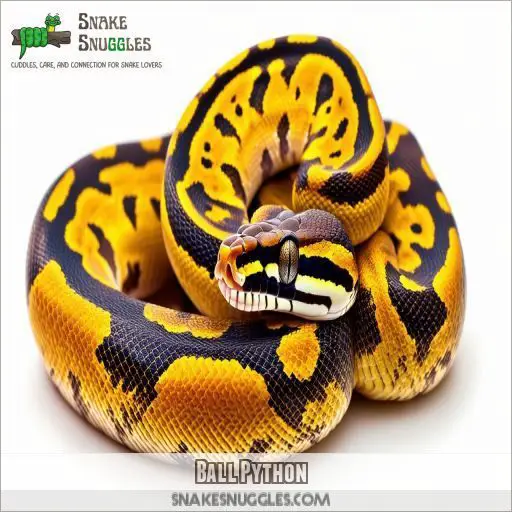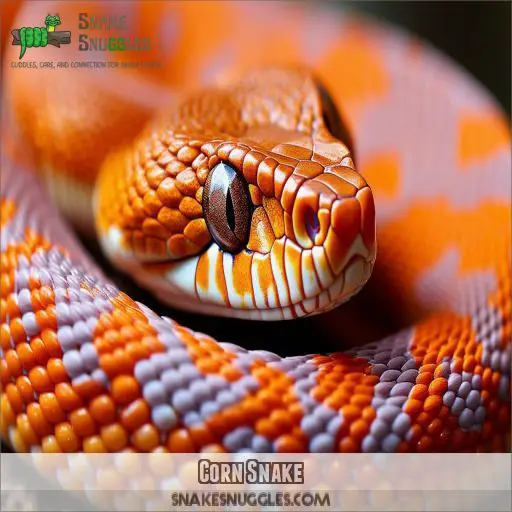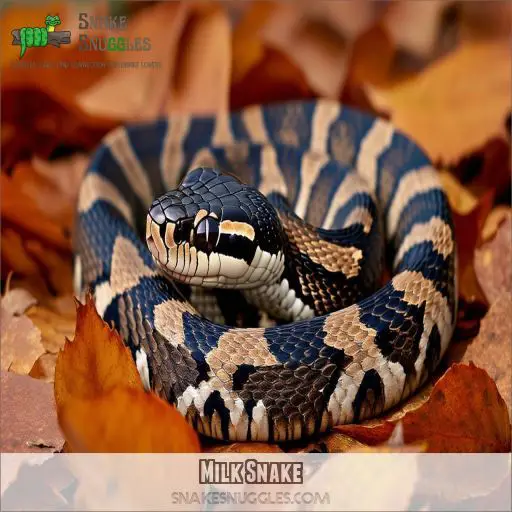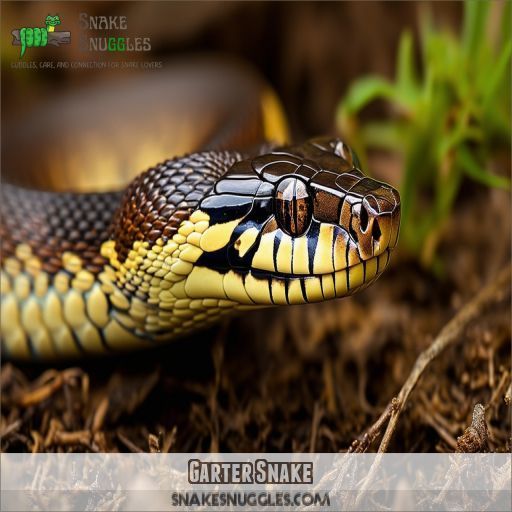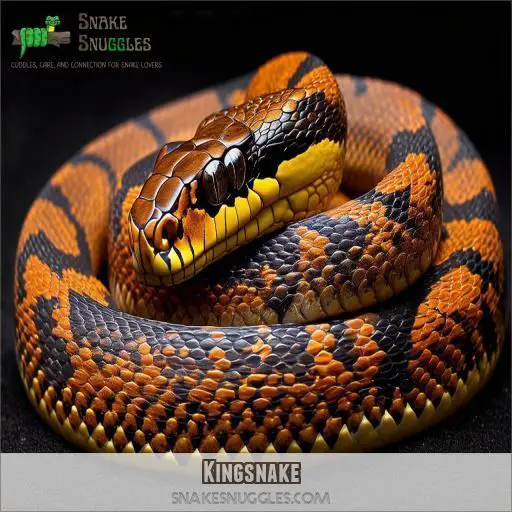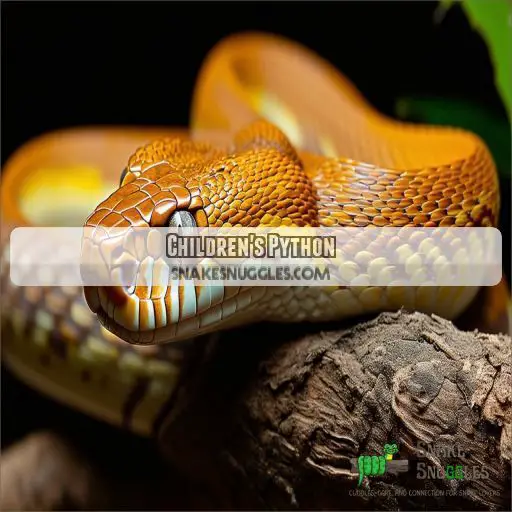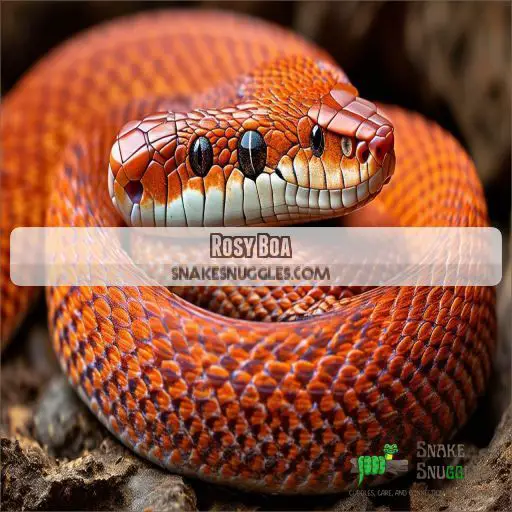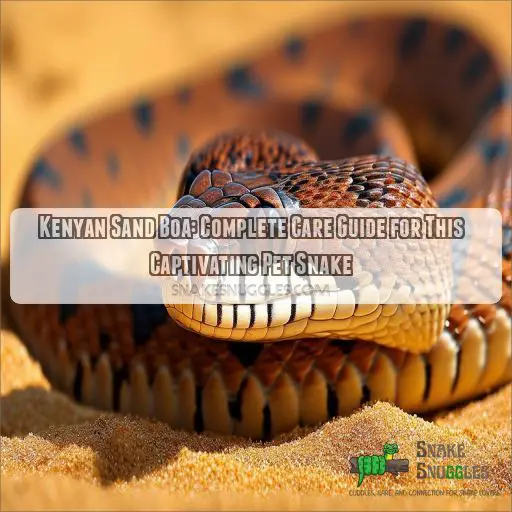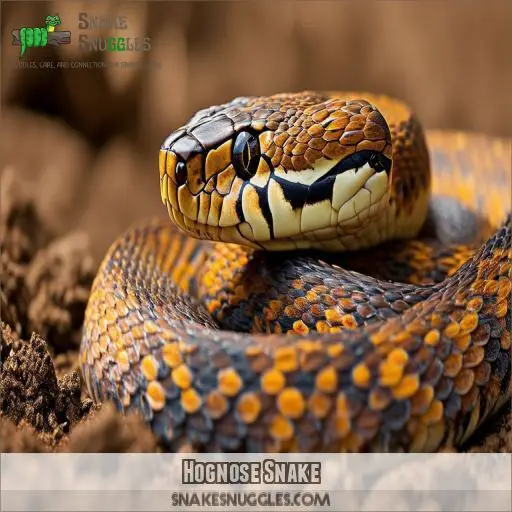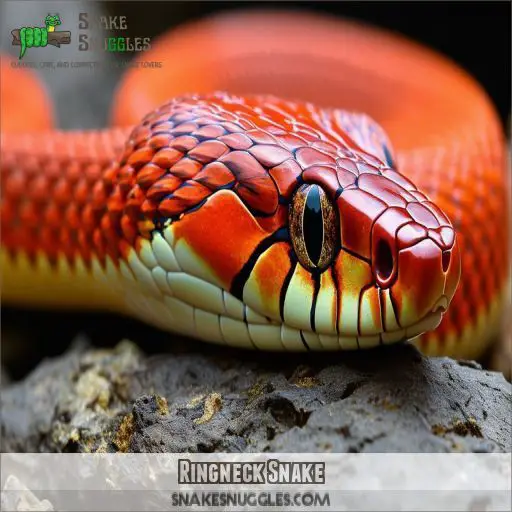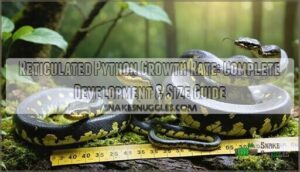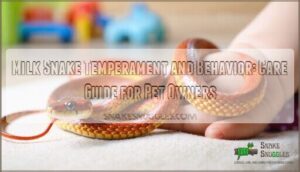This site is supported by our readers. We may earn a commission, at no cost to you, if you purchase through links.
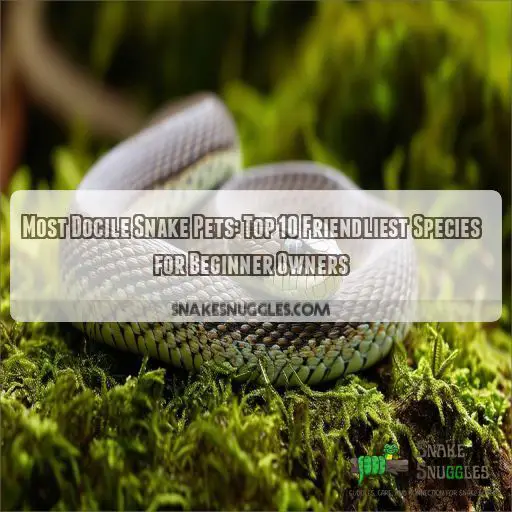 When looking for the most docile snake to keep as a pet, you’ll find several fantastic options. Ball pythons are known for their calm temperament and are easy to handle, plus they’ve got a variety of colors and patterns to keep things interesting.
When looking for the most docile snake to keep as a pet, you’ll find several fantastic options. Ball pythons are known for their calm temperament and are easy to handle, plus they’ve got a variety of colors and patterns to keep things interesting.
Corn snakes are incredibly docile and beginner-friendly, making them a great first snake.
Milk snakes also rank high for their calm disposition and come in bright, attractive patterns.
Garter snakes, with their gentle temperament and small size, are perfect for those who want a pet that’s easy to manage.
If you want to explore more friendly species, there’s much more to discover!
Table Of Contents
- Key Takeaways
- Ball Python
- Corn Snake
- Milk Snake
- Garter Snake
- Kingsnake
- Children’s Python
- Rosy Boa
- Kenyan Sand Boa
- Hognose Snake
- Ringneck Snake
- Frequently Asked Questions (FAQs)
- What is the most docile snake for a pet?
- What is the friendliest snake to own?
- What is the least aggressive snake pet?
- What snakes are cuddly?
- Which snakes make good pets for kids?
- How often do beginner-friendly snakes eat?
- Can docile snakes be housed together?
- What size enclosure is suitable for beginners?
- Do beginner snakes require special lighting or heating?
- Conclusion
Key Takeaways
- Corn snakes take the crown for chill vibes, making them the go-to choice for snake newbies. These slithery sweethearts are about as laid-back as a surfer on a sunny beach!
- Ball pythons are the gentle giants of the snake world. With their calm demeanor and stunning variety of colors, they’re like the mood rings of the reptile kingdom – beautiful and always in a good mood.
- If you’re looking for a pint-sized pal, the ringneck snake might be your perfect match. These tiny tots are so small and secretive, you might find yourself playing hide-and-seek with your new scaly friend.
- When it comes to housing your docile darling, remember: snakes are the introverts of the animal world. They prefer their own bachelor pad, so resist the urge to throw a snake roommate mixer – it won’t end well!
Ball Python
If you’re seeking a pet snake, it’s tough to beat the ball python due to its calm temperament and ease of handling (Source). Furthermore, its variety of colors and patterns adds an element of aesthetic appeal for many owners (Source).
Calm Temperament
Ball pythons are naturally shy animals that exhibit defensive behaviors when stressed, which can be minimized by understanding their behavior through a ball python temperament review. Ball pythons are celebrated for their calm temperament. Unlike more skittish species, they exhibit temperament differences that make them ideal for beginners. Their docile nature, combined with manageable socialization needs and gentle handling techniques, enhances their training potential and enriches your experience with one of the most docile snakes available.
Ease of Handling
Handling a ball python as a pet snake is incredibly straightforward due to its calm temperament. Its moderate size guarantees manageable strength, and with proper humidity needs and cage size, it’s easy to create a comfortable environment. This gentle snake’s predictable behavior makes it stress-free to handle daily.
Variety of Colors and Patterns
Ball Pythons are renowned for their morph variations, showcasing an array of pattern combinations and colors. Their unique scales result from specific color genetics, carefully bred by enthusiasts. You’ll find them in a broad palette, from vivid yellows to deep blacks, making them an eye-catching choice among pet snakes for beginners.
Corn Snake
Corn snakes are renowned for their docile nature, making them an excellent choice for beginner snake owners. They’re easy to care for and budget-friendly, ensuring a smooth start to your snake-keeping journey (Source).
Docile Nature
To continue from the Ball Python, the Corn Snake’s docile nature makes it ideal for beginners. They’re generally curious and easy to handle. Their temperament differences include:
- Friendly disposition
- Regular feeding habits
- Adaptable to various environments
- Responsive to socialization techniques
These traits guarantee a seamless pet-keeping experience.
Beginner-Friendly Care
Corn snakes are excellent for beginner-friendly care. They’re easy to house with simple substrate, consistent temperature, and basic lighting needs. Here’s a comparison:
| Requirement | Corn Snake | Children’s Python |
|---|---|---|
| Housing | 20-gallon tank | 10-gallon tank |
| Feeding | Mice | Small rodents |
| Temperature | 75-85°F | 80-90°F |
Affordable to Purchase and Care For
Corn snakes are cost-effective pets. They require minimal feeding, with a diet primarily of inexpensive rodents . Their maintenance is budget-friendly, needing simple enclosures, easily managed with aspen bedding . This makes them an affordable option when compared to other snake pets . Your wallet will thank you!
Milk Snake
Milk snakes are renowned for their calm disposition, making them an exceptionally beginner-friendly snake species. Additionally, their variety of subspecies and bright, attractive patterns add to their appeal, ensuring there’s a milk snake for every preference.
Calm Disposition
Milk snakes are ideal pets for beginners due to their calm dispositions and friendly temperaments . They rarely exhibit aggression, reducing concerns about bites . Properly handled, they offer enriching interactions. Regular handling decreases anxiety and builds trust. Overall, their patient personalities make them excellent companions.
- Friendly Temperament
- Low Aggression
- Easy Training
- Enriching Interactions
- Safe Handling
Variety of Subspecies
Milk snakes offer impressive subspecies diversity. Selective breeding enhances this variation, resulting in striking differences among them. In captive care, they exhibit unique genetic traits beneficial for conservation efforts. This diversity makes them fascinating snake pets, analogous to a Children’s Python in terms of adaptability and attractiveness .
Bright, Attractive Patterns
Milk snakes are renowned for their bright, attractive patterns, making them a visual delight. You can explore:
- Unique colorations: From vibrant reds to stark whites.
- Morphs and variations: Each subspecies, like the Pueblan or Honduran, offers different looks.
- Pattern genetics: Their bands or stripes vary by region and habitat.
Garter Snake
Garter snakes are renowned for their gentle temperament, making them an excellent choice for both new and experienced snake owners. Their small size and varied diet, which can include insects, amphibians, and small fish, add to their appeal as beginner-friendly pets.
Gentle Temperament
Garter snakes are known for their gentle temperament, making them ideal snake pets with minimal handling frequency and high suitability for children. They generally don’t mind interaction and require a simple enclosure. Their snake health thrives with basic care, distinguishing them as docile snake pets comparable to the Children’s Python.
Small Size
When choosing beginner snake pets with a gentle temperament, don’t overlook small-sized species like the garter snake. These petite reptiles rarely exceed 3.5 feet and boast manageable care needs.
- Compact enclosures
- Garter snake care simplicity
- Ease of handling
- Adaptable habitat
Their size makes them ideal for constrained spaces.
Varied Diet
Regarding varied diets, garter snakes are notable. They consume a range of prey, from earthworms to fish. This makes garter snake feeding both fascinating and diverse. Here’s a quick overview of their diet:
| Prey | Protein | Ease of Access | Frequency |
|---|---|---|---|
| Earthworms | High | Easy | Weekly |
| Fish | Medium | Moderate | Weekly |
| Frogs | High | Easy | Monthly |
| Rodents | High | Moderate | Monthly |
This range guarantees a balanced diet for your garter snake.
Kingsnake
Kingsnakes are renowned for their calm behavior, making them exceptionally suited for first-time snake owners . Their wide array of attractive patterns adds a visual appeal that many enthusiasts appreciate .
Calm Behavior
Kingsnakes are known for their friendly nature and adaptability, making them suitable for beginners. Their docility means they’re less likely to bite, perfect for those hesitating about handling a snake.
Like a Children’s Python, these calm snakes thrive with minimal stress. Proper care includes adequate snake substrates and sourcing from reputable snake breeders to ensure healthy pets.
They’re clearly one of the gentlest species around.
Attractive Patterns
Kingsnakes are known for their strikingly attractive patterns, making them a popular choice among snake enthusiasts. Their color mutations range from vibrant reds and oranges to sleek blacks and whites. When considering pattern genetics, focus on these desirable pattern traits:
- Striped Kingsnakes: Display distinct stripes running the length of their bodies.
- Banana Kingsnakes: Known for their bright, yellow hues interspersed with dark splotches.
- Halloween Morphs: Feature bold, contrasting orange and black patterns.
These striking patterns result from selective breeding for patterns and color variations.
Children’s Python
Children’s Pythons are known for their extremely docile personalities, making them ideal pets. With their small adult size and long lifespan of up to 30 years, they’re a great fit for beginner snake owners.
Docile Personality
Children’s pythons are celebrated for their docile personality. When engaging in handling techniques, be gentle and consistent. Their enclosure size should match their 2-4 feet length. Dietary needs include small rodents, and maintaining their health involves regular check-ups. Breeding considerations are minimal, adding to their appeal for beginners .
Small Adult Size
The Children’s Python boasts a small adult size, making it perfect for small cages. Hatchlings require simple care, while gender differences don’t affect temperament. They tolerate cohabitation well, promoting easy handling. Regular handling, even at a young age, guarantees they remain calm and manageable as they grow.
Long Lifespan
Children’s Pythons are excellent for beginners due to their modest size and long lifespan. These snakes can live up to 30 years, making them a lifelong companion.
- Relatively easy to maintain health considerations
- Require simple enclosure requirements
- Rodent diet, making feeding straightforward
Rosy Boa
The Rosy Boa, known for its gentle nature, moves slowly and maintains a compact size, making it an excellent choice for novice snake owners. Enjoy the calm demeanor, deliberate pace, and manageable dimensions of this docile snake species, ideal for those seeking a friendly and easy-to-handle pet.
Gentle Nature
Rosy Boas have a gentle nature, making them superb for beginners. These snakes exhibit diverse genetic patterns, adapting to various habitats. They’re easy to care for with simple feeding habits and minimal health issues.
| Feature | Description |
|---|---|
| Temperament | Gentle and docile |
| Habitat Variation | Wide adaptability |
| Feeding Habits | Small rodents |
Slow Movement
Rosy Boas epitomize a laid-back lifestyle with their slow growth and restrained movement. They’re slow to bite, making them a safe choice for beginners. Their low prey drive and shy behavior align with their peaceful nature, offering a calm and engaging pet experience suitable for anyone seeking a gentle serpentine companion.
Compact Size
The Rosy Boa’s compact size makes it perfect for beginners. With easy care and straightforward feeding, it’s a hassle-free pet. The species is known for its gentle temperament and can thrive in a simple enclosure. You’ll appreciate:
- Minimal space requirements
- Manageable feeding routines
- Gentle handling experiences
Kenyan Sand Boa
Kenyan Sand Boas make fantastic pets for beginners due to their calm demeanor and small size. They’re easy to care for, requiring minimal space and simple feeding routines.
Calm Demeanor
Kenyan Sand Boas are recognized for their calm demeanor, making them ideal for tight spaces. With the right calm enclosure, they thrive in captivity. Proper handling and regular socialization are essential. Use effective feeding techniques, and monitor their shedding process closely. These measures guarantee a healthy, content snake.
Miniature Size
Kenyan Sand Boas have a miniature size, making them perfect for small enclosures. With housing needs of just a 10-gallon tank, they require a substrate type like aspen to burrow. Maintain low humidity requirements and handle them weekly to guarantee they stay docile and friendly .
Ease of Care
Continuing from the Kenyan Sand Boa’s miniature size, let’s explore its ease of care:
- Cost of Care: Affordable initial setup and maintenance.
- Feeding Schedule: Requires feeding every 1-2 weeks, typically small rodents.
- Housing Requirements: A 10-gallon tank suffices, with substrate for burrowing and minimal heating.
Hognose Snake
The Hognose Snake is an excellent choice if you’re looking for a snake with a unique personality and fascinating bluffing behavior. This species also comes in a variety of colors, adding an intriguing aesthetic to their charm.
Unique Personality
Hognose snakes have a unique personality, displaying fascinating social behavior and submissive postures. They use fear responses to communicate, enhancing trust-building with their handlers. Understanding reptile empathy can help you bond with these snakes, making them excellent pets for those who appreciate distinctive, engaging behaviors.
| Behavior | Description |
|---|---|
| Social Behavior | Intriguing interactions with surroundings |
| Submissive Postures | Non-aggressive responses |
| Fear Responses | Unique defense mechanisms |
| Trust Building | Encourages a strong bond |
Bluffing Behavior
Hognose snakes are known for their fascinating bluffing behavior. They mimic deadly snakes by inflating their necks to form a false head, rattling their tails, and even playing dead. This harmless snake is an expert at deception, providing a unique and entertaining pet experience.
Variety of Colors
Hognose snakes stand out with their unique patterns and vibrant hues, making them a colorful addition to any collection. They come in rare morphs, offering diverse color combinations that fascinate enthusiasts. Their pattern genetics are complex, producing stunning snakes that are as beautiful as they’re easy to care for .
Ringneck Snake
Ringneck snakes are praised for their tiny size, making them easy to house and handle. Their secretive nature and simple care requirements make them suitable for those new to snake keeping.
Tiny Size
The Ringneck Snake, with its small size, is a perfect choice for beginners looking for a manageable pet. Its timid behavior and unique markings add to its charm. Being inexpensive and hypoallergenic, this species offers an accessible option for those new to snake ownership, ensuring ease of care and enjoyment.
Secretive Nature
Ringneck snakes are secretive by nature, often hiding during the day. They prefer nocturnal activity and thrive with the right conditions:
- Substrate preferences: Soft soil or leaf litter encourages their natural burrowing behavior.
- Humidity requirements: Maintain sufficient humidity for optimal health.
- Handling precautions: Handle gently, as they’re delicate.
Ease of Captive Care
When caring for a Ringneck Snake, you’ll appreciate its simple needs. Maintain a small enclosure, about 10-20 gallons, and create a temperature gradient of 70-80°F. Keep humidity between 40-60%, and use leaf litter or aspen bedding as the substrate.
| Aspect | Specification |
|---|---|
| Enclosure Size | 10-20 gallons |
| Temperature | 70-80°F |
| Humidity | 40-60% |
| Substrate Type | Leaf litter, Aspen |
| Feeding Schedule | Weekly (small invertebrates) |
Frequently Asked Questions (FAQs)
What is the most docile snake for a pet?
The most docile pet snake is often considered the Corn Snake. They’re easy to handle, have manageable care needs, and rarely refuse food, making them an excellent choice for beginners .
What is the friendliest snake to own?
If you’re looking for the friendliest snake, consider a corn snake. They’re docile, easy to handle, come in various colors, and adapt well to captivity, making them excellent pets for both beginners and experienced keepers .
What is the least aggressive snake pet?
Imagine holding a creature as serene as a summer breeze; the corn snake stands out as the least aggressive pet snake. It’s known for its docile nature, manageable size, and ease of care .
What snakes are cuddly?
For a cuddly pet snake, consider the ball python. They’re known for their calm nature, making them perfect for gentle handling. Their docility and manageable size make them a favorite among snake enthusiasts .
Which snakes make good pets for kids?
Corn snakes, ball pythons, and milk snakes make excellent pets for kids due to their docile nature, manageable size, and easy care requirements. They’re also visually striking and come in a variety of colors and patterns .
How often do beginner-friendly snakes eat?
You’ll need to feed your beginner-friendly snake every 7-14 days, depending on its age and size. Young snakes eat more often, while adults can go longer between meals. Always offer appropriately sized prey for your snake’s safety.
Can docile snakes be housed together?
You shouldn’t house docile snakes together. They’re solitary creatures and can become stressed or aggressive when sharing space. Even peaceful species may compete for resources or accidentally injure each other. It’s best to keep them in separate enclosures.
What size enclosure is suitable for beginners?
Time to slither into snake keeping! You’ll want an enclosure that’s a breeze for your scaly friend. For beginners, start with a 20-30 gallon tank, ensuring it’s escape-proof and well-ventilated.
Do beginner snakes require special lighting or heating?
Yes, beginner snakes need proper heating and lighting. You’ll want a basking spot with a heat lamp and a cooler area. UVB lighting isn’t essential but can be beneficial. Monitor temperatures closely to guarantee your snake’s health.
Conclusion
Choosing the most docile snake as your pet opens up a world of fascinating options. From the gentle ball python to the tiny ringneck snake, you’ve got plenty of calm companions to contemplate.
Whether you’re drawn to the corn snake’s beginner-friendly nature, which makes them suitable pets due to their docile and even-tempered personality, or the hognose’s quirky personality, there’s a docile snake out there that’s perfect for you.
With proper care and respect, you’ll find these reptiles make surprisingly serene and rewarding pets.

